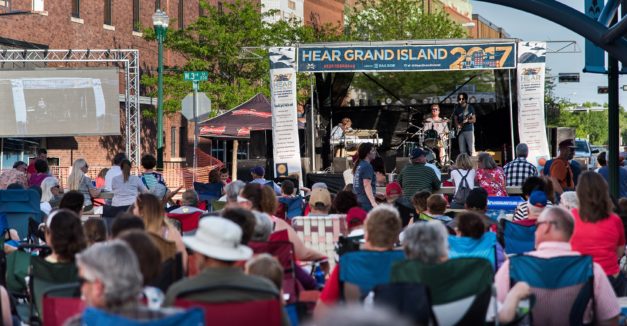This 2017 Good Living Tour Storytelling Project piece publishes thanks to a grant from Humanities Nebraska, and the Nebraska Cultural Endowment. The Good Living Tour is presented by the Nebraska Department of Economic Development with generous support from Peter Kiewit Foundation, Nebraska Community Foundation, Pinnacle Bank, Nebraska Loves Public Schools, Union Pacific, The Center for Rural Affairs, and the Nebraska Arts Council.
* * *
Drive through downtown Grand Island on a summer Friday night and the rumbles of drums and guitar will begin to rattle your car’s windows. Head through streets lined with Renaissance Revival mid-rises toward the sound, and you’ll pass health clinics, churches and taekwondo dojos using the prefix “Third City.” Though only a reference to Grand Island’s former status as Nebraska’s third largest community (Bellevue has claimed that ranks since the 2010 Census), it’s as if the city accepts an underdog role without an Interstate exit. But as the sound grows louder, hundreds of people packing a closed-off road come into view and that sentiment begins to melt.
At Hear Grand Island, the annual concert series stationed at the central Nebraska city’s Railside Plaza, any hints of an inferiority complex are replaced with contentment. On the first night of the second concert series, more than 1,000 Grand Islanders descend upon the city’s downtown to catch hometown country-rockers Whiskey Bent. Kids frolic near the stage, parents watch from the comfort of their lawn chairs and food trucks sell burritos and fried rice. The city moves closer to reaching a re-envisioned potential.


Hundreds of Grand Island residents gather for the 2017 Hear Grand Island launch | photos by Emma Petersen
* * *
After arriving Railside for 2017’s inaugural Hear Grand Island concert, I quickly spot Sharena Anson, who coordinates Hear Grand Island with Brent Lindner and their live entertainment company Knife & Fork Productions. The show starts in two hours and Anson is lugging around boxes of Jack Daniels and directing volunteers who arrange the dozens of porta-potties around Hear Grand Island’s refreshments concourse. She moves with authority, but not the kind that intimidates. She stops to listen to her volunteers’ questions about whether they should add more ice to a mountain of bottled water and Diet Coke and returns to her own focus.
Well, Anson is focused on a couple things. First, she wants to see the opening night of the concert series run smoothly and draw a healthy number of Grand Islanders. And, more broadly, she wants to be a catalyst for culture in Grand Island.
“When I was shared the opportunity [to coordinate Hear Grand Island], it was a no-brainer, because to me, it really just said that we could start the arts and entertainment scene for this city,” Anson says. “I think a lot of people are ready for it.”
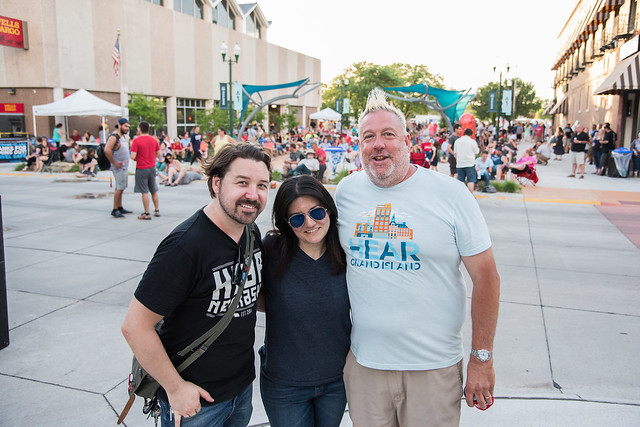
Hear Grand Island organizers, from left: T.J. Roe, Sharena Anson, Brent Lindner
It’s no easy task, though, to make art and culture the norm in an isolated, mid-sized town in the middle of Nebraska.
But the proof of a willing arts community is at The Chocolate Bar, Anson’s downtown dessert shop and café near Third and Locust streets, which she co-owns with her husband, Amos. Through discussions with Chocolate Bar regulars, Sharena says she has found an active, art-loving community that wants to see Grand Island thrive as a destination for artists and entrepreneurs. Hear Grand Island could be the launching point to establishing an arts-appreciative culture there.
“Ultimately, I think it will be a really good thing for the kids coming up, the people that are here, and then to get the kids who are growing up to stay here,” Anson says.
Anson’s concerns with keeping kids in Grand Island are common among many small business owners and entrepreneurs in the town of 51,000 who watch annually as millennials ditch rural communities for major metropolitan areas. Grand Island’s 18-to-34 year-old population decreased about 6-percent from 1980 to 2013. The decline follows a national trend of young adults leaving their small towns as soon as they are of age and not returning in the same numbers as 30 years ago.
Talk with various store managers in downtown Grand Island, and the words “ghost town” come up more than once to describe the city’s future if it can’t find a way to keep millennials from packing up. And it certainly doesn’t help that Grand Island doesn’t have a public four-year university ‒ only Central Community College ‒ to keep high school seniors from heading to Lincoln, Omaha or even Kearney.

Jump The Tiger | photo by Emma Petersen
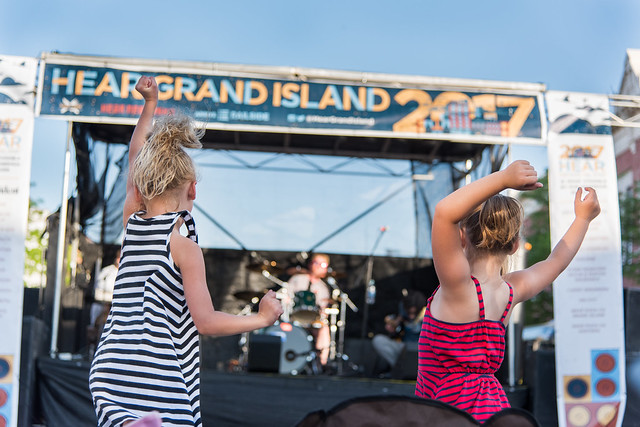
Two young Grand Island residents dance by the stage during Hear Grand Island | photo by Emma Petersen
Not all of the high school graduates want to leave, however.
Since graduating in May, Hear Grand Island intern Spencer Goodman has been instrumental in the early stages of fostering a youth culture that celebrates art and music in GI. As an aspiring visual artist and fan of punk music, Goodman, 18, naturally looked around at his classmates for people who shared similar interests. He found a few, like fellow visual artist and collaborator Marco Gracia. But what he couldn’t find was a local scene with which to share his work.
He and Garcia, 19, spoke with administrators at local galleries to show their art, but he says they were turned down because of their ages. The only venues hosting live music were bars with 21-and-up rules or county and state fairs. Many of Goodman’s weekends often began with a friend posing the question, “Hey, do you want to go to Omaha or Lincoln?”
Goodman and Garcia have frequented Omaha art hubs such as KANEKO and The Bemis Center for Contemporary Arts, where they experience what an arts culture looks like in a place where it is actively fostered. But weekend after weekend of hours driving east on I-80 grow tiresome.
“After a while, it just gets kind of old,” Goodman says. “So we started thinking, ‘Wouldn’t it just be more fun if we could just do this ourselves?”
Now, Anson has taken Goodman under her wing, offering The Chocolate Bar as a venue to host live music and art showings. Goodman has Lindner’s Wave Pizza Co. as a backup, and in the event that neither is available, he says he’ll just settle for his backyard. Meanwhile, Garcia is heading up the challenge of securing building permits for the basement below his parents’ downtown Hispanic market to hold art showings.
It’s a process, but it’s already paying off. In early July, Goodman and Garcia held an art showing for their work in a Third Street downtown GI space called The Birdhouse, and they say nearly 30 people attended the event. The turnout is fuel for Goodman’s and Garcia’s shared belief in the potential of Grand Island, and the same vision that pushed Anson to oversee Hear Grand Island.
“I would rather just stay and try to do it here and start something rather than just go somewhere where it’s already started,” Goodman says.
* * *
When I spot Lindner, he’s adjusting the barricades blocking off Third Street for the night’s concert. He has a voice that carries for hundreds of yards across the plaza without turning into a shout, and he wears a tight-fitting baby blue T-shirt with “Hear Grand Island” stamped across the front. He is a long-time punk, and it still shows with his brick-colored boots and bleach-blonde mohawk.
Lindner has worked at and owned bars for 31 years, and today he runs four downtown Grand Island dining staples: Wave Pizza Co., The Glass Bar, Sin City and J. Alfred Prufrock’s.
“My mom always said I would end up behind bars, and I did,” Lindner jokes over the muted hard rock of 2017’s first Hear Grand Island performers, The Whiskey Drinkers Union. We talk inside Arrive Railside’s dimly lit offices fewer than 100 feet from the stage. The music filters through the front doorway in waves as Hear Grand Island volunteers enter and exit throughout.
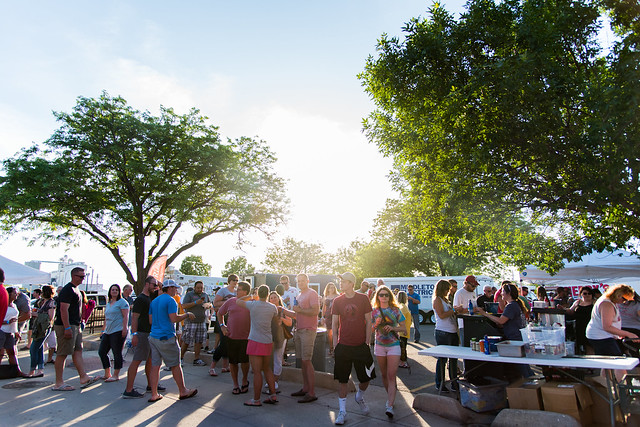
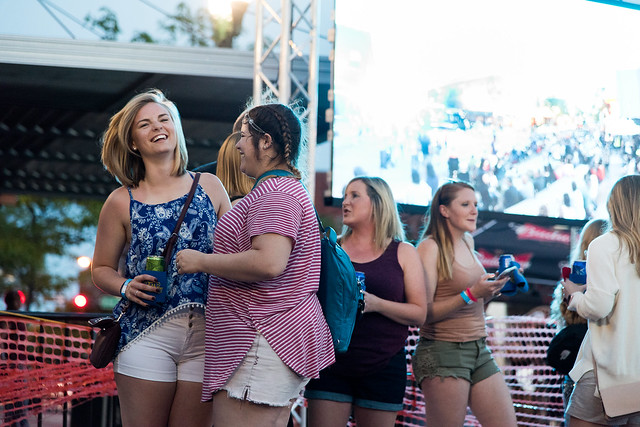
Fans congregate around food trucks and beer tents at Hear Grand Island | photo by Emma Petersen
Before settling back in Grand Island in the mid-’90s, Lindner moved to Southern California on a basketball scholarship in 1986, where he befriended surfers who worked in the restaurant industry. He dropped out of school soon after and immersed himself in the West Coast food culture, working at various restaurants so he could surf in his free time.
Eventually, after a stint working with the Quiksilver surf company in Australia, Lindner returned to Nebraska to study at Hastings College with his new California experiences. Lindner opened the beach-themed Wave Pizza Co. in 2001, anchored by a new desire to establish Grand Island as a cultural hub and to break what he sees as the misconception that GI is “boring.”
“You always hear that there’s nothing to do here, and I thought that too when I moved to Southern California,” Lindner says. “But there’s really a ton of shit to do here.”
There are the obvious attractions, like the Stuhr Museum and Fonner Park, which has hosted the Nebraska State Fair since 2010. Grand Island is gradually building a notable culinary community, too, with Kinkaider Brewing Company of Broken Bow adding a location in downtown Grand Island earlier this year and a pair of Asian restaurants, Wasabi Bistro and Fuji Japanese Steakhouse, opening in the past decade. And, of course, Lindner’s four restaurants and The Chocolate Bar thrive downtown. Lindner hosts concerts at The Glass Bar once or twice a month, and Wave Pizza holds the occasional open mic night. And when Conor Oberst played a free show as part of HGI last year, Lindner says he received praise for getting “every millennial within 100 miles to come to this.”
Still, the Grand Island music scene is in its infancy, and Lindner knows it. There’s live music in Grand Island, but not enough to build a community of consistently performing local bands. And it’s another battle to lure touring acts away from the Interstate, because, as Lindner says, “a lot of them just drive right by.” That’s why, when given the opportunity, Lindner joined Anson to organize Hear Grand Island.
“[Hear Grand Island is] just kind of a launching board to show that an arts scene is viable and that it can be done,” Lindner says.
So far, Hear Grand Island has proven successful, with Lindner putting just as much care and effort into the series as he does at his four restaurants. More than 1,200 people filled Railside Plaza to see Grand Island country-rock heroes Whiskey Bent on the series’ first night. The same band drew 2,000 to close out Hear GI in 2016. And both times, frontman Tim Zach has been pleased with the turnout.
“I’m really surprised and impressed at the same time with the support the community has given the concert series,” Zach says when we speak over the phone. “It’s bringing not only younger people from just Grand Island, but I think it’s drawing younger people from the smaller communities around Grand Island that are within 40 or 50 miles.”
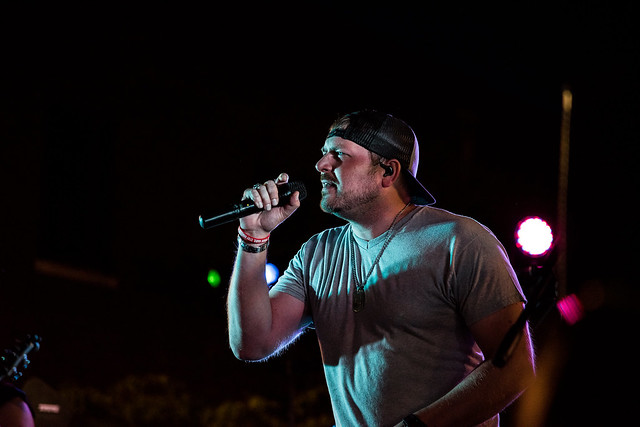
Whiskey Bent lead vocalist Tim Zach
In the nine weeks of 2016’s Hear Grand Island series, Lindner says 9,500 people packed Railside Plaza, and he just wants to see it continue to blossom as go-to entertainment in Grand Island.
But when you step outside the barricades blocking Railside Plaza from Third Street’s west and eastbound traffic, away from the music and the hundreds of fans, it’s easy to see why some might find Grand Island “dull” or “boring.” Small shops and bars line the once-vibrant street, but at many of the storefronts, a pull on the doorknob yields only the surprise of a lock as just a handful of businesses stay open past 6 p.m.
On the first night of Hear Grand Island, I stop at Kindred, a women’s fashion and lifestyle boutique on the ground floor of the old, eight-story Masonic Temple building a block east of Railside Plaza. Two or three people comb through racks of summer blouses and rustic bureaus of jewelry.
Chelsea Sackschewsky opened Kindred in 2014 after moving to GI from Colorado with hopes of strengthening the city’s core as a byproduct of success. She has made it three years, but she knows that there’s always a risk, especially with her downtown location.
“I believe that it’s necessary for growth in Grand Island and I think people want it, but it’s whether they actually show up to support it or not,” Sackschewsky says of her store.
She takes the same stance when asked about Hear Grand Island. During the 2016 concert series, Kindred kept its doors open past its normal 6 p.m. closing time, expecting to see more concertgoers milling through downtown. A few wanderers came in to check out the store, she says, but she was mostly disappointed with the results.
Sackschewsky says she is staying optimistic again this year, hoping Hear Grand Island creates a ripple effect for the rest of downtown.
“Hopefully, if it really takes off, all the businesses will stay open later, more people will come downtown, and it’ll just continue to grow from there,” she says. “I hope soon we see people showing up and speaking out, like ‘wow, I never used to go downtown, but that’s the place to be.’”
* * *
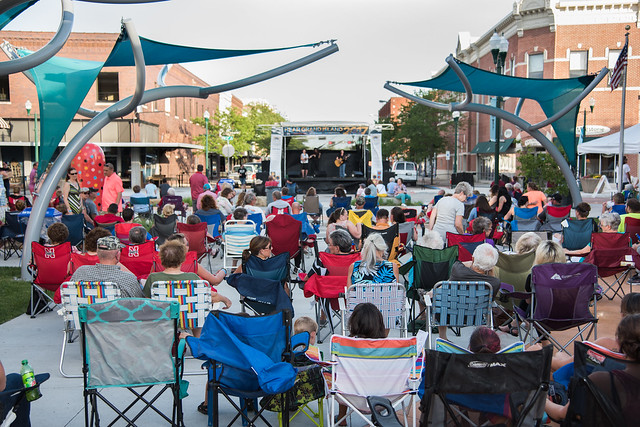
The Shineys perform for a large Hear Grand Island crowd | photo by Emma Petersen
I return to Grand Island on June 16 for the third week of the concert series while the eastern part of Nebraska is blasted with hail and 100 mile per hour winds. The sun shines brightly as a light breeze blows and trains pass on the north side of downtown. It should be business as usual for Lindner, Anson and their crew, but when I arrive around 5 p.m., the stage crew that was supposed show up an hour ago just called Lindner to say they’ll be late.
By week three, any show prep jitters should be gone. But when 6 o’clock rolls around and there’s still no stage, Lindner paces around the empty Railside Plaza debating whether to delay the show by a half hour. When an isolated storm cloud edges its way toward downtown, covering the plaza in a gloomy haze, Lindner is given no choice.
By the time the stage crew pulls into the barricaded plaza sporting a spare tire, the storm system, which seemingly planned to wash over Railside Plaza all along, has just begun spitting light rain.
The stage crew, each member wearing all black, scrambles out of its tired van to set up before the storm hits. Lindner and Sharena offer to help, but when the clouds start gushing rain and small hail, the two are forced under a nearby awning to wait for things to settle down.
Rain only lasts for about 10 minutes, but it has dropped enough water on the plaza that the employees at Mama’s food truck use brooms to sweep the puddles standing in front of the truck down the drain.
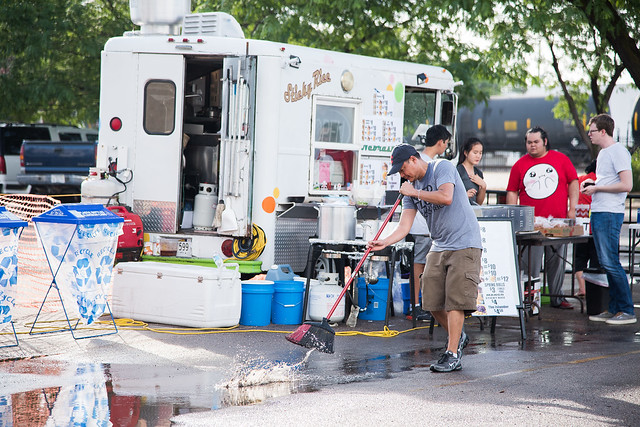
A vendor sweeps away rainwater after a storm passes before Hear Grand Island | photo by Emma Petersen
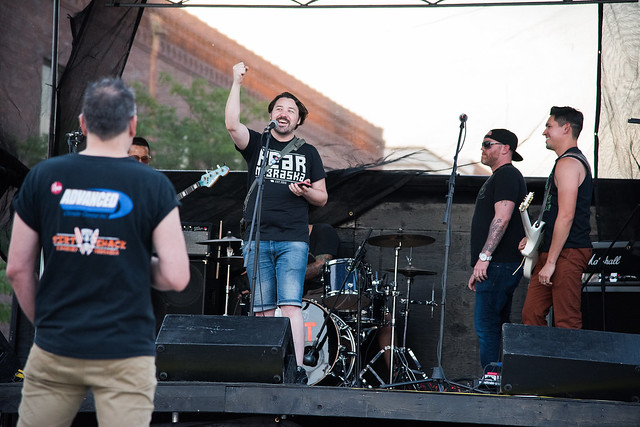
Hear Grand Island production manager T.J. Roe addresses the crowd post-storm | photo by Emma Petersen
When the stage is finally set up, the crew’s van needs a jump start. If there’s any silver lining, it’s that The Shineys, the night’s first band, only need to soundcheck a guitar, a ukulele and a violin, so music is ready to start at 7:30, just a half hour behind schedule.
Before The Shineys set, Hear Grand Island production manager T.J. Roe takes the stage. He’s a Grand Island ex-pat himself, who returned but then relocated to Lincoln and now travels weekly to run the concert series. In jean shorts and black sunglasses, he addresses the crowd that’s slowly formed in the plaza after the storm.
“Hey everybody look how brave you are,” Roe says into the microphone, “You guys are true Nebraskans.”
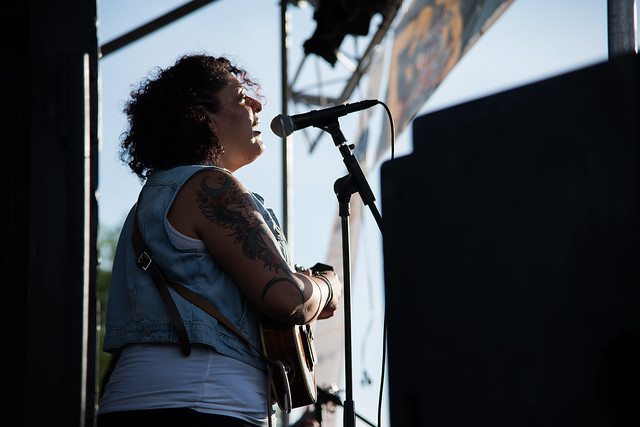
The Shineys perform at Hear Grand Island | photo by Emma Petersen
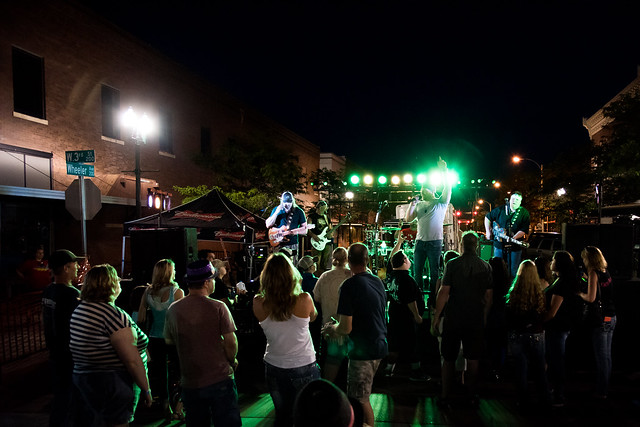
Tim Zach & Whiskey Bent | photo by Emma Petersen
Maybe it is a testament to the willpower and drive of Nebraskans that a rainstorm can drench an outdoor concert venue minutes before a show and have it still run without a hitch. Or maybe it’s just what makes sense; to always push forward and strive for constant growth because of pride for your state and pride for what you do.
Lindner and Anson certainly don’t do what they do because they think everything will run perfectly every night. To them, it just makes sense to keep working until downtown Grand Island is, again, the place to be.
After the nerves leave, Lindner takes in the night as the sun sets and The Shineys’ somber yet hopeful country harmonies sweep across Railside Plaza. He lets out a relieved sigh and says, “I think I’m ready for a beer.”




